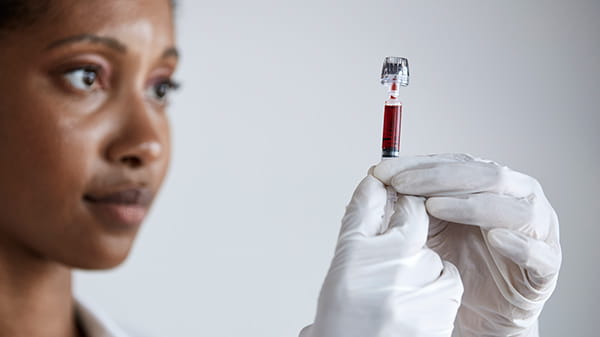
ABL800 FLEX blood gas analyser
Offering you trusted results and greater operational efficiency
-
 Reliable results on 18 vital parameters
Reliable results on 18 vital parameters
-
 Spend less time in front of the analyser with FLEXQ
Spend less time in front of the analyser with FLEXQ
-
 Configured to meet your needs
Configured to meet your needs
Reliable, Efficient, Flexible
Amidst pressures to optimise resources and personnel, equip and empower busy laboratory staff with:
- Results you can trust
- Improved workflow
- A flexible partner to meet your needs

"Drop-n-Go" on the FLEXQ
Fully automatic scanning, mixing, and aspiration of blood samples
Easy to operate screen
Intuitive interface with highly responsive tablet-like interaction
Additional clinical insight
Measure up to 18 critical parameters on one sample to support fast diagnosis
Autocheck
Supporting compliance with automatic QC
Parameters measured
Potential of hydrogen
The degree of acidity or alkalinity of any liquid (including blood) is a function of its hydrogen ion concentration [H+], and pH is simply a way of expressing hydrogen ion activity. The relationship between pH and hydrogen ion concentration is described thus:
pH = -log aH+
where aH+ is hydrogen ion activity.
Low pH is associated with acidosis and high pH with alkalosis [1,2].
- CLSI. Blood gas and pH analysis and related measurements; Approved Guidelines. CLSI document CA46-A2, 29, 8. Clinical and Laboratory Standards Institute, 940 West Valley Road, Suite 1400, Wayne, Pennsylvania 19087-1898 USA, 2009
- Acute care testing handbook. Radiometer Medical ApS, 2700 Brønshøj, Denmark, 2014. As accessed on https://www.radiometer.com/en/knowledge-center/handbooks/acute-care-testing-handbook
Partial pressure of carbon dioxide
Carbon dioxide (CO2) is an acidic gas; the amount of CO2 in blood is largely controlled by the rate and depth of breathing or ventilation. pCO2 is the partial pressure of CO2 in blood. It is a measure of the pressure exerted by that small portion (~5 %) of total CO2 that remains in the gaseous state, dissolved in the blood plasma. pCO2 is the respiratory component of acid-base balance and reflects the adequacy of pulmonary ventilation. The severity of ventilator failure as well as the chronicity can be judged by the accompanying changes in acid-base status [1,2].
- Higgins C. Parameters that reflect the carbon dioxide content of blood. www.acutecaretesting.org Oct 2008.
- Acute care testing handbook. Radiometer Medical ApS, 2700 Brønshøj, Denmark, 2014
Partial pressure of oxygen
The amount of oxygen in blood is controlled by many variables, e.g. ventilation/perfusion. pO2 is the partial pressure of oxygen in a gas phase in equilibrium with the blood. pO2 only reflects a small fraction (1 – 2 %) of total oxygen in blood that is dissolved in blood plasma [1]. The remaining 98 – 99 % of oxygen present in blood is bound to the hemoglobin in the erythrocytes. pO2 primarily reflects the oxygen uptake in the lungs. [2]
1. Wettstein R, Wilkins R. Interpretation of blood gases. In: Clinical assessment in respiratory care, 6th ed. St. Louis: Mosby, 2010.
2. Acute care testing handbook. Radiometer Medical ApS, 2700 Brønshøj, Denmark, 2014. As accessed on https://www.radiometer.com/en/knowledge-center/handbooks/acute-care-testing-handbook.
Glucose
Glucose, the most abundant carbohydrate in human metabolism, serves as the major intracellular energy source (see lactate). Glucose is derived principally from dietary carbohydrate, but it is also produced – primarily in the liver and kidneys – via the anabolic process of gluconeogenesis, and from the breakdown of glycogen (glycogenolysis). This endogenously produced glucose helps keep blood glucose concentration within normal limits, when dietary-derived glucose is not available, e.g. between meals or during periods of starvation. [1]
1. Acute care testing handbook. Radiometer Medical ApS, 2700 Brønshøj, Denmark, 2014. As accessed on https://www.radiometer.com/en/knowledge-center/handbooks/acute-care-testing-handbook.
Lactate, the anion that results from dissociation of lactic acid, is an intracellular metabolite of glucose. It is produced by skeletal muscle cells, red blood cells (erythrocytes), the brain, and other tissues during anaerobic energy production (glycolysis). Lactate is formed in the intracellular fluid from pyruvate; the reaction is catalyzed by the enzyme lactate dehydrogenase (LDH) [1,2].
1. Robergs RA, Ghiasvand F, Parker D. Biochemistry of exercise-induced metabolic acidosis. Am J Physiol Regul Integr Comp Physiol 2004; 287: R502-16.
2. Acute care testing handbook. Radiometer Medical ApS, 2700 Brønshøj, Denmark, 2014. As accessed on https://www.radiometer.com/en/knowledge-center/handbooks/acute-care-testing-handbook.
Creatinine
Creatinine is an endogenous waste product of muscle metabolism, derived from creatine, a molecule of major importance for energy production within muscle cells. Creatinine is removed from the body in urine and its concentration in blood reflects glomerular filtration and thereby kidney function. [1]
1. Acute care testing handbook. Radiometer Medical ApS, 2700 Brønshøj, Denmark, 2014. As accessed on https://www.radiometer.com/en/knowledge-center/handbooks/acute-care-testing-handbook.
Calsium
The calcium ion (Ca2+) is one of the most prevalent cations in the body, where approximately 1 % is present in the extracellular fluid of blood. Ca2+ plays a vital role for bone mineralization and many cellular processes, e.g. contractility of the heart and the skeletal musculature, neuromuscular transmission, hormone secretion and action in various enzymatic reactions such as, e.g. blood coagulation. [1]
1. Acute care testing handbook. Radiometer Medical ApS, 2700 Brønshøj, Denmark, 2014. As accessed on https://www.radiometer.com/en/knowledge-center/handbooks/acute-care-testing-handbook.
Chloride
Chloride (Cl-) is the major anion in the extracellular fluid and one of the most important anions in blood. The main function of Cl- is to maintain osmotic pressure, fluid balance, muscular activity, ionic neutrality in plasma, and help elucidate the cause of acid-base disturbances. [1]
1. Acute care testing handbook. Radiometer Medical ApS, 2700 Brønshøj, Denmark, 2014. As accessed on https://www.radiometer.com/en/knowledge-center/handbooks/acute-care-testing-handbook.
Potassium
Potassium (K+) is the major cation in the intracellular fluid, where it has a 25 - 37-fold higher concentration (∼150 mmol/L in tissue cells, ∼105 mmol/L in erythrocytes) than in the extracellular fluid (∼4 mmol/L) [1, 2]. K+ has several vital functions in the body, e.g. regulation of neuromuscular excitability, regulation of heart rhythm, regulation of intracellular and extracellular volume and acid-base status. [3]
1. Burtis CA, Ashwood ER, Bruns DE. Tietz textbook of clinical chemistry and molecular diagnostics. 5th ed. St. Louis: Saunders Elsevier, 2012.
2. Engquist A. Fluids/Electrolytes/Nutrition. 1st ed. Copenhagen: Munksgaard, 1985.
3. Acute care testing handbook. Radiometer Medical ApS, 2700 Brønshøj, Denmark, 2014. As accessed on https://www.radiometer.com/en/knowledge-center/handbooks/acute-care-testing-handbook.
Sodium
Sodium (Na+) is the dominant cation in the extracellular fluid, where it has a 14-fold higher concentration (∼140 mmol/L) than in the intracellular fluid (∼10 mmol/L). Na+ is a major contributor of the osmolality of the extracellular fluid and its main function is largely in controlling and regulating water balance, and maintaining blood pressure. Na+ is also important for transmitting nerve impulses and activating muscle concretion. [1]
1. Acute care testing handbook. Radiometer Medical ApS, 2700 Brønshøj, Denmark, 2014. As accessed on https://www.radiometer.com/en/knowledge-center/handbooks/acute-care-testing-handbook.
Carboxyhemoglobin
FCOHb is the fraction of total hemoglobin (ctHb) which is present as carboxyhemoglobin (COHb). By convention the fraction is expressed as a percentage (%).
In the range of 0 – 60 % COHb in arterial (COHb(a)) and venous blood (COHb(v)) is similar, i.e. either venous or arterial blood may be analyzed [1]. In most medical texts FCOHb(a) is referred to as simply COHb. [2]
1. Lopez DM, Weingarten-Arams JS, Singer LP, Conway EE Jr. Relationship between arterial, mixed venous and internal jugular carboxyhemoglobin concentrations at low, medium and high concentrations in a piglet model of carbon monoxide toxicity. Crit Care Med 2000; 28: 1998-2001.
2. Acute care testing handbook. Radiometer Medical ApS, 2700 Brønshøj, Denmark, 2014. As accessed on https://www.radiometer.com/en/knowledge-center/handbooks/acute-care-testing-handbook.
Bilirubin
Bilirubin is the yellow breakdown product of the degradation of the heme group of hemoglobin. It is transported in blood from its site of production – the reticuloendothelial system – to the liver, where it is biotransformed before excretion in bile. Jaundice, the pathological yellow discoloration of skin, is due to abnormal accumulation of bilirubin in the tissues, and is always associated with elevated blood concentration of bilirubin (hyperbilirubinemia). [1]
1. Acute care testing handbook. Radiometer Medical ApS, 2700 Brønshøj, Denmark, 2014. As accessed on https://www.radiometer.com/en/knowledge-center/handbooks/acute-care-testing-handbook.
Total hemoglobin
The concentration of total hemoglobin (ctHb) in blood includes oxyhemoglobin (cO2Hb), deoxyhemoglobin (cHHb), as well as the dysfunctional hemoglobin species that are incapable of binding oxygen:
carboxyhemoglobin (cCOHb) (see COHb), methemoglobin (cMetHb) (see MetHb) and sulfhemoglobin (cSulfHb).
Thus:
ctHb = cO2Hb + cHHb + cCOHb + cMetHb + cSulfHb
The rare sulfHb is not included in the reported c tHb in most oximeters. [1]
1. Acute care testing handbook. Radiometer Medical ApS, 2700 Brønshøj, Denmark, 2014. As accessed on https://www.radiometer.com/en/knowledge-center/handbooks/acute-care-testing-handbook.
Fraction of fetal hemoglobin
FHbF in total hemoglobin in blood. [1]
1. Acute care testing handbook. Radiometer Medical ApS, 2700 Brønshøj, Denmark, 2014. As accessed on https://www.radiometer.com/en/knowledge-center/handbooks/acute-care-testing-handbook.
Fraction of deoxyhemoglobin
FHHb in total hemoglobin in blood. [1]
1. Acute care testing handbook. Radiometer Medical ApS, 2700 Brønshøj, Denmark, 2014. As accessed on https://www.radiometer.com/en/knowledge-center/handbooks/acute-care-testing-handbook.
Metahemoglobina
FMetHb is the fraction of total hemoglobin (ctHb) that is present as methemoglobin (MetHb). By convention the fraction is expressed as a percentage (%) [1]. In most medical text boxes MetHb(a) is referred to as simply methemoglobin (MetHb). [2]
1. CLSI. Blood gas and pH analysis and related measurements; Approved Guidelines. CLSI document CA46-A2, 29, 8. Clinical and Laboratory Standards Institute, 940 West Valley Road, Suite 1400, Wayne, Pennsylvania 19087-1898 USA, 2009.
2. Acute care testing handbook. Radiometer Medical ApS, 2700 Brønshøj, Denmark, 2014. As accessed on https://www.radiometer.com/en/knowledge-center/handbooks/acute-care-testing-handbook.
Oxygen saturation
Oxygen saturation (sO2) is the ratio of oxyhemoglobin concentration to concentration of functional hemoglobin (i.e. oxyhemoglobin (O2Hb) and deoxyhemoglobin (HHb) capable of carrying oxygen [1].
The sO2 reflects utilization of the currently available oxygen transport capacity. In arterial blood 98 – 99 % of oxygen is transported in erythrocytes bound to hemoglobin. The remaining 1–2 % of the oxygen transported in blood is dissolved in the blood plasma – this is the portion reported as partial pressure of oxygen (pO2) [2,3].
1. CLSI. Blood gas and pH analysis and related measurements; Approved Guidelines. CLSI document CA46-A2, 29, 8. Clinical and Laboratory Standards Institute, 940 West Valley Road, Suite 1400, Wayne, Pennsylvania 19087-1898 USA, 2009.
2. Higgins C. Parameters that reflect the carbon dioxide content of blood. www.acutecaretesting.org Oct 2008.
3. Acute care testing handbook. Radiometer Medical ApS, 2700 Brønshøj, Denmark, 2014. As accessed on /en/knowledge-center/handbooks/acute-care-testing-handbook.
Fraction of oxyhemoglobin
FO2Hb in total hemoglobin in blood. [1]
1. Acute care testing handbook. Radiometer Medical ApS, 2700 Brønshøj, Denmark, 2014. As accessed on https://www.radiometer.com/en/knowledge-center/handbooks/acute-care-testing-handbook.
The equipment I use in my work must be trustworthy, user-friendly and reliable […] For more than ten years, we’ve been using the ABL800 series from Radiometer. It works very well for us.
- Anna-Karin Ståhlberg, Biomedical Analyst, Clinical Chemistry Laboratory, Halland´s Hospital Halmstad, Sweden
Click here to renew consent
How can we help you facilitate Seamless Diagnostics?

Confidently meet health care challenges with a trusted analyser
- Support sample integrity
- Mitigate the influence of potentially interfering substances on co-oximetry and creatinine
- Provide reliable results using dedicated measuring modes

Supporting an improved blood gas workflow with efficient automation
Combine your ABL800 FLEX and safePICO syringes with AQURE's FLEXLINK system to utilise 1st Automatic. The connected solution registers patient, operator and sample IDs at the bedside, while FLEXLINK links these data together. An example of how it could expedite your workflow is shown below.


Improve your blood gas workflow with automation and connected solutions

A flexible partner in meeting your needs
To find out more, contact your local Radiometer representative. We're here to support you in constructing your unique setup.

Built-in cybersecurity helps increase uptime
Our cyber security model operates as a multi-layered defense system, alongside hospital security measures. Based on Microsoft-supported operating systems, our proactive model includes Application Control, Patch management and system updates tested prior installation. Visit our Security Packages to learn more.


Experience the Power of Seamless Diagnostics
Cookies are used on this website
Use of cookiesPlease enter a valid email
We will be sending an e-mail invitation to you shortly to sign in using Microsoft Azure AD.
It seems that your e-mail is not registered with us
Please click "Get started" in the e-mail to complete the registration process
Radiometer is using Microsoft AZURE Active Directory to authenticate users
Radiometer uses Azure AD to provide our customers and partners secure access to documents, resources, and other services on our customer portal.
If your organization is already using Azure AD you can use the same credentials to access Radiometer's customer portal.
Key benefits
- Allow the use of existing Active Directory credentials
- Single-sign on experience
- Use same credentials to access future services
Request access
You will receive an invitation to access our services via e-mail when your request has been approved.
When you accept the invitation, and your organization is already using AZURE AD, you can use the same credentials to access Radiometer's customer portal. Otherwise, a one-time password will be sent via e-mail to sign in.






